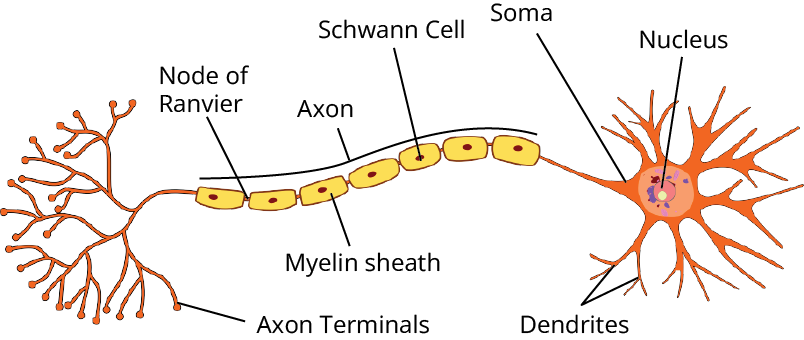Neural Control and Coordination Class 11 Extra Questions and Answers Free PDF Download
FAQs on CBSE Important Questions for Class 11 Biology Neural Control and Coordination - 2025-26
1. What are the most important topics to prepare from the CBSE Class 11 Biology Chapter 18 – Neural Control and Coordination for the 2025-26 exam?
- Structure and function of neurons
- Transmission of nerve impulses (including saltatory conduction)
- Reflex action and reflex arc
- Central and peripheral nervous systems
- Autonomic nervous system—sympathetic vs parasympathetic
- Sensory organs (eye and ear anatomy, mechanism of vision and hearing)
- Human brain regions and associated functions
- Differences between rods and cones
2. Which types of questions are frequently asked in CBSE Class 11 Biology exams from Neural Control and Coordination?
- Short answer questions on neural structure and synapse function
- Diagram-based questions (neuron, reflex arc, human eye/ear)
- Differences (e.g., between CNS and PNS, rods and cones, dorsal and ventral roots)
- Mechanism-focused HOTS (e.g., conduction of impulse, reflex action steps, saltatory conduction)
- Application: identifying neural defects, predicting outcomes of nerve damage
3. What is saltatory conduction, and why is it advantageous in myelinated nerve fibres? (CBSE 2025–26, 3-mark)
- Saltatory conduction is the process where action potentials jump from one node of Ranvier to the next in a myelinated nerve fibre.
- This sharply increases the speed of impulse transmission by skipping insulated segments.
- It is energy efficient and ensures rapid responses in higher organisms.
4. How does the structure of the human eye support the mechanism of vision? (CBSE Conceptual FUQ)
- The cornea and lens refract light onto the retina for focused images.
- The iris controls light entry for optimal vision in varying brightness.
- Photoreceptor cells (rods and cones) in the retina transform light into nerve impulses.
- Nerve signals then travel via the optic nerve to the visual cortex for processing.
5. Compare the structures and functions of the central and peripheral nervous systems. Why is this distinction important?
- Central nervous system (CNS): Made up of the brain and spinal cord; processes, interprets, and stores information; coordinates all body functions.
- Peripheral nervous system (PNS): All nerves outside CNS; relays messages to and from CNS; includes somatic and autonomic systems.
- This distinction is vital because CNS damage leads to loss of control/coordination, while PNS injury affects sensory/motor pathways.
6. What is a reflex arc and how does it ensure a fast response? (CBSE 2025–26, HOTS/FUQ)
- A reflex arc is a neural pathway that mediates an automatic response to a stimulus.
- It involves a receptor, sensory neuron, relay neuron, motor neuron, and effector.
- By bypassing the brain for simple decisions, reflex arcs enable immediate protective actions, such as withdrawing from a hot object.
7. Why are impulses conducted only in one direction at synapses? (Common conceptual FUQ)
- At a synapse, only the presynaptic neuron contains neurotransmitter vesicles and releases chemical signals into the synaptic cleft.
- Postsynaptic neurons possess receptors for these chemicals.
- This chemical arrangement ensures impulses propagate in one direction only.
8. List common misconceptions students have about the autonomic nervous system.
- Confusing voluntary and involuntary control: Autonomic nervous system (ANS) regulates involuntary actions only.
- Assuming sympathetic and parasympathetic always work oppositely—They often do, but can sometimes both be active (e.g., sexual response).
- Mistaking all automatic responses as ANS-mediated: Some reflexes are mediated via the CNS only.
9. How do rods and cones function differently in the human retina? (Expected 2-mark)
- Rods are sensitive to dim light and are responsible for black-and-white vision; they contain rhodopsin pigment.
- Cones function in bright light and enable color vision; they contain iodopsin pigment.
- This distinction allows humans to see in both daylight and low-light conditions.
10. What are the roles of cerebrospinal fluid (CSF) in the nervous system? (Frequently asked, CBSE 2025–26)
- Protects the brain and spinal cord by absorbing shocks
- Provides nutrients to nervous tissue
- Removes metabolic wastes and toxins
11. Explain the marking scheme and typical question distribution for Chapter 18 in the CBSE Class 11 Biology Board Exam 2025–26.
- Chapter 18 usually contributes 2 to 5 marks through a mix of 1-mark very short, 2/3-mark short, and 5-mark long questions.
- High-weightage topics: neural pathways, reflex mechanisms, sensory organ functions.
- Unit 5 (Human Physiology) as a whole accounts for ~18 marks, so mastering this chapter boosts your overall score.
12. How does damage to the corpus callosum affect body coordination? (Conceptual FUQ)
- The corpus callosum connects the two cerebral hemispheres.
- Damage impairs communication between right and left brain sides, affecting motor coordination, problem-solving, and sensory integration.
13. What events occur during a nerve impulse transmission at the axon terminal? (Expected HOTS, CBSE 2025–26)
- Arrival of action potential at axon terminal opens voltage-gated calcium channels.
- Calcium influx triggers synaptic vesicle fusion with the membrane.
- Neurotransmitter is released into the synaptic cleft, binding receptors on the next neuron.
- This generates a new action potential in the postsynaptic neuron (one-way flow).
14. How can students avoid common errors in diagram-based questions from Neural Control and Coordination?
- Label all parts clearly and accurately (e.g., neuron, synapse, reflex arc, eye, ear)
- Include direction of impulse flow
- Ensure anatomical proportions are reasonable and key segments present (e.g., node of Ranvier, lens, cochlea)
- Practice CBSE previous years' and sample diagrams for best results
15. Why is threshold stimulus important in neural function? (High-order expected FUQ)
- Threshold stimulus is the minimum intensity required to depolarize a neuron and initiate an action potential.
- Ensures neurons only respond to sufficiently strong signals, preventing accidental firing due to random fluctuations.



























